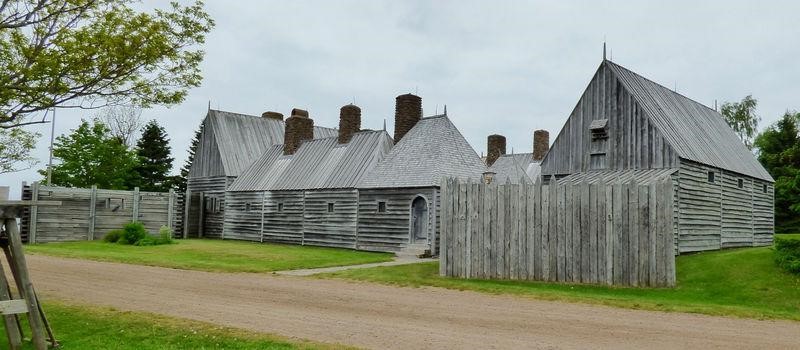After an exceptionally disastrous harsh winter (1604-05) on St. Croix Island where nearly half of the 79 French colonists died of scurvy, Pierre Dugua de Mons (born in Royan, France) decided to move his establishment to Port Royal, so named by his crew. The site is majestic and easy to defend (now Annapolis Royal). In his annals Samuel de Champlain describes it as being “one of the most beautiful harbours that I have seen in all these shores”, adding “the cleanest and most pleasant to inhabit that we have seen”. The Mi’kmaq First Nation, then called “Souriquois” by the newcomers, warmly welcomes them to “Algatig”, meaning “our place/village/camp”. According to the Mi’kmaqs, the land was fertile and the surrounding natural environment was rich in fish and game. In the spring of 1605, the remaining men of the expedition (there are no women) set to work constructing buildings with the materials they brought back from St. Croix.


According to Champlain’s sketches, Port Royal Habitation is a large rectangle 18 meters (60 feet) long by 15 meters (48 feet) wide, resembling a fortified hamlet such as existed in France in the early 1600s. At the southwest corner of the rectangle, the pioneers built a bastion armed with four cannons. The structure includes accommodation for the settlers, which are allocated to them according to their rank. Occupying the north corner of the Habitation, is a small house with a sloping roof with cut sides, where Pont-Gravé and Champlain lived in 1605-06. Next to this house is a row of smaller lodgings for officers. A Catholic priest and a Protestant pastor live there, as well as surgeon Deschamps and a seasoned shipwright by the name of Champdoré. To the southwest is a dormitory for skilled workers.
At the heart of the Franco-British conflicts
During the first century of its existence, Port Royal was the capital of Acadia and its most populous town. From 1613 to 1710 it changed sovereignty between the kingdom of France and that of Great Britain no less than eight times.
In 1613, Samuel Argall and his armed men, who had come from Virginia, attacked Port Royal and destroyed it completely. Eight years later, King James I of Great Britain granted Acadia, which he renamed Nova Scotia, to William Alexander. The latter erected Fort Anne around 1629. In 1632, the Treaty of Saint-Germain-en-Laye restored New France (Port Royal and Quebec City) to France. Then in 1654 Robert Sedgewick, Commander-in-Chief of the New England Fleet, captured Port Royal in retaliation for activities of the French corsairs against English ships, thus bringing Acadia under the British Crown. In 1667, Port Royal was again returned to France with the Treaty of Bréda. According to the 1671 census, Port Royal region then had 361 residents. In 1690 Acadia once again became a victim of clashes. William Phips attacked and pillaged Port Royal on behalf of Massachusetts. Thanks to the 1697 Treaty of Ryswick, Acadia was returned to France for a third time. In 1710, the Lieutenant Governor of Maryland, Francis Nicholson, and Samuel Vecht, accompanied by a force of 3,400 men, easily captured Port Royal, defended by only 300 soldiers. Daniel d´Auger de Subercase, Governor of Acadia, surrendered without loss of life. Port Royal is then renamed Annapolis Royal in honor of Queen Anne of Great Britain. Vecht becomes its governor. Three years later with the signing of the 1713 Treaty of Utrech, France ceded Peninsular Acadia to the United Kingdom, but kept Isle Royale (Cape Breton) and Isle St. Jean (Prince Edward Island). The vast majority of Acadians remained on their land and definitively passed under British rule. Right away after 1713, France undertook the construction of the fortress of Louisbourg.
Over the Franco-British conflicts, Acadians multiplied and continued to spread from Port Royal to Pubnico (Pobomcoup) in 1653, Beaubassin (Amherst) in 1672, Minudie (Cumberland County) in 1672, Rivière-aux-Canards (Canard) in 1675, Grand-Pré in 1682, Pisiguit (Windsor) in 1684, Chezzetcook (Halifax) in 1688, and Cobequid (Truro) in 1689.
It is obvious that Port Royal, at the epicenter of the lucrative (cod) Grand Banks that have become a battleground between great powers, did serve as a bargaining chip between two empires. Acadia was therefore a territory with constantly contested borders, fluctuating with clashes and treaties thus rendering oaths of allegiance uncertain and governance unstable. Today, it is with a spirit of renewal that the Acadian people, who have become an admirable diaspora, flourish on the world scene, still guided by the Stella Maris as well as by the philosophy of Socrates, a famous thinker of ancient Greece, who said “The secret of change is to focus all your energy not on fighting the past, but on building the future”.

